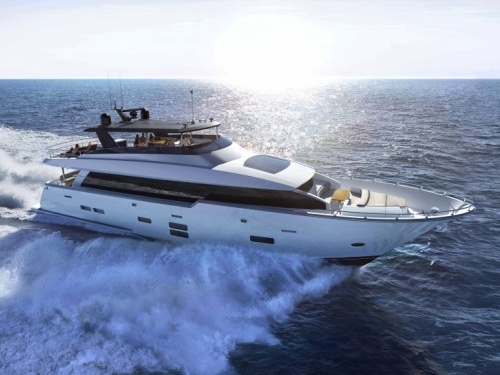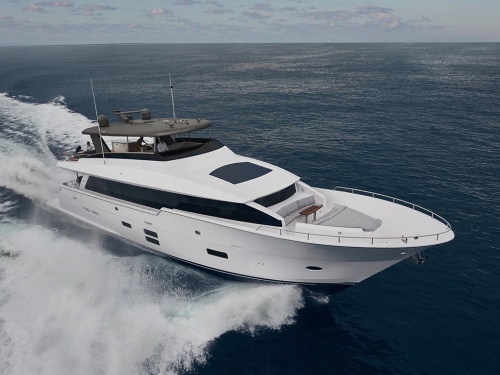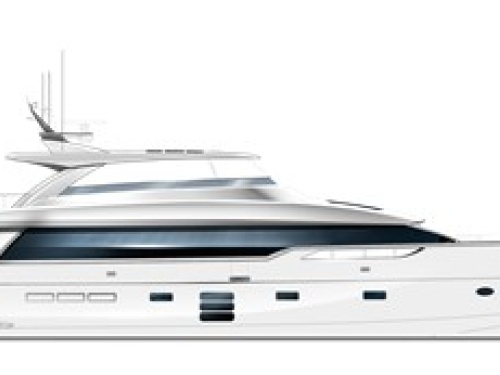Brief Summary
The new Hatteras 100 Raised Pilothouse motoryacht heralds this venerable company’s return to the market with all Kalenberg trumpets blasting. She has a sleek, new style and a sure-footed aggressiveness that announces that now – with her new owner – Hatteras is very much back in business. She is just one of three new Hatteras yachts being introduced this winter, the others are a 45 Express and a 70’ (21 m) motoryacht which will debuted at FLIBS. Make no mistake about it, this is a real motoryacht designed and built for people who want to own a real motoryacht, not just a floating platform good for little more than going from marina to marina on the French Riviera. No, she is designed to do it all, as her 275,000 lb. (124,738 kg) displacement, her 4,660-gallon (17,640 L) fuel capacity, and her twin Cat C32A 1900-hp diesels makes clear in no uncertain terms.
Key Features
- Designed by Enrico Gabbi
- Large aft deck and salon
- Optional on-deck master suite
- Salon and galley features panoramic windows and signature skylights
- Standard twin Cat C-32A diesel engines
- 4,660 gallons (17,640 L) in fuel capacity
- 2 diesel generators at 40.0 kW each
Specifications
| Length Overall |
102' 0'' / 31.09 m
|
| Beam |
22' 6''
6.86 m
|
| Dry Weight |
275,000 lbs.
124,738 kg
|
| Draft |
6' 2''
1.88 m
|
| Deadrise/Transom |
N/A
|
| Max Headroom |
N/A
|
| Bridge Clearance |
N/A
|
| Fuel Capacity |
4,660 gal.
17,640 L
|
| Water Capacity |
820 gal.
3,104 L
|
Engine Options
| Tested Engine |
Currently no test numbers
|
| Std. Power |
2 x 1900-hp Cat C-32A diesel
|
| Opt. Power |
Not Available
|
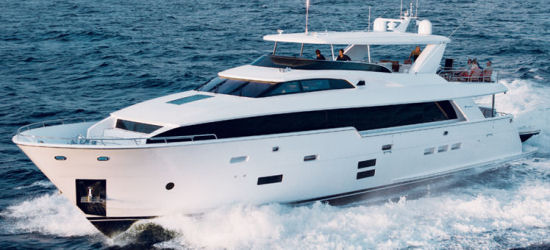 The all-new Hatteras 100 Raised Pilothouse has a 22’6” (6.86 m) beam and is ready to go anywhere and entertain, dayboat, or go long distance cruising in high style.
The all-new Hatteras 100 Raised Pilothouse has a 22’6” (6.86 m) beam and is ready to go anywhere and entertain, dayboat, or go long distance cruising in high style.
Mission
This vessel has several missions and they all dovetail into the creation of a stylish production motoryacht that can go toe-to-toe with any motoryacht from Europe when it comes to a modern, pleasing external design. By creating a sleek pilothouse motoryacht with rounded contours, low, angled windshields, and main-deck side windows stretching nearly the length of the main deck, Hatteras has shot a canon ball across the bows of several brands we can think of.
Hatteras is also signaling that not only can it be as modern and as au current-looking as any vessels coming out of Italy – but that it can do it with taste, functionality, and a degree of ergonomic correctness that we often see lacking in some European-built yachts.
Mission #2
was to create a large motoryacht that can handle a variety of assignments as is, and others with easily made modifications. Her flying bridge and main deck can be configured in a number of different ways. In all cases she has embraced with alacrity the most popular layouts and concepts extant in this class of motoryacht. Which is to say, if an owner wants an informal Country Kitchen instead of a European-style out-of-sight-out-of-mind galley, it can be done. If an owner wants a different treatment than those seen on this page, we’re told that all that he or she needs to do is ask.
Mission #3
is to continue what Hatteras has always done best – build rugged, seaworthy vessels with systems designed and installed among the best of any builder in the world. Hatteras engineers were instrumental in helping to formulate the ABYC standards that all U.S. builders strive to achieve. It was born in the epicenter of America’s fine furniture producing area, and from what we have seen, the 100 Raised Pilothouse’s fit-and-finish carries on that tradition.
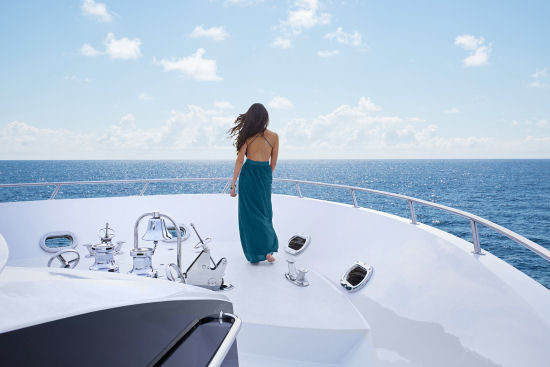
Nothing could signal the change in approach at Hatteras more than the publicity photos seen on this page. Large motoryachts are about more than a strong hull and an orderly engine room. Now the builder is clearly embracing the more romantic aspects of ownership as well as the mechanical.
Inspection
The Flying Bridge

The standard flying bridge layout of the Hatteras 100 Raised Pilothouse motoryacht features a long flying bridge intended for all sorts of entertaining. Note that the “boat deck” is used here for chaise lounges and sunning as well as al fresco dining.

In this version we see that the boat deck is actually being used to carry the tender – but remember, when the yacht is at the dock or anchored out, the tender is usually in the water and the cradle can be easily removed to make way for those three chaise lounges. Hot tub anyone? Simply ask. There is plenty of room for one.
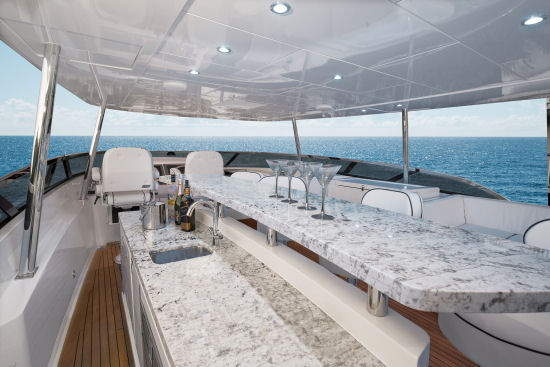
The granite countertop and bar is large enough to handle most any party. Note the two Stidd chairs for captain and companion in the background. High bulwarks on the flying bridge are one of the distinguishing characteristics of this vessel.
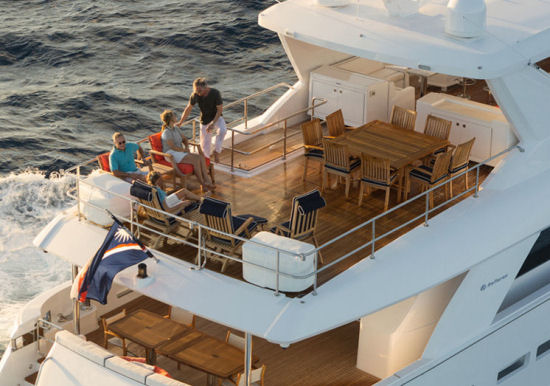
This sun deck reminds us of what might be found on a small cruise ship, complete with bar, and deck chairs. Shuffleboard, anyone? Note that the upper deck completely covers the aft deck, allowing guests to pick sun or shade. The aft deck can be surrounded in isinglass to provide a three-season venue.
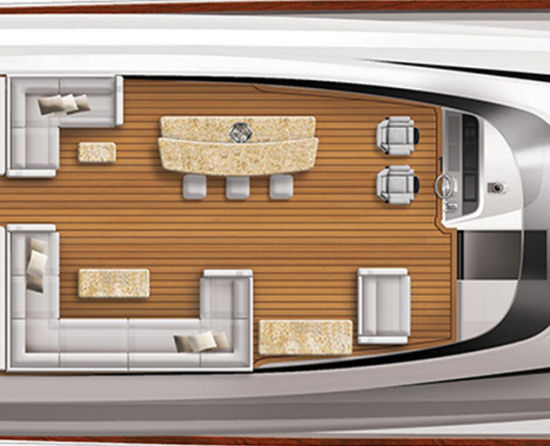
Here we see a magnified view of the forward entertaining area of the flying bridge. This is the area covered by a hardtop and it will probably be the most popular place for guests.

An alternative version has formal dining for eight opposite the granite counter bar. Note the two chairs at the helm, which we like to see, along with the double-wide seat to starboard so that four people can face forward while the boat is running.
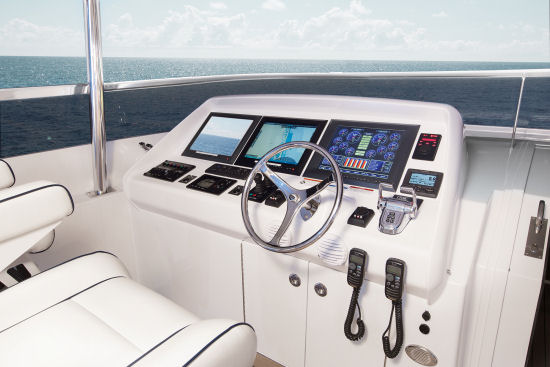
The helm on the flying bridge is clean and large. The joysticks to operate both the bow and the stern thrusters are located to the left of the wheel so that the captain can stand outboard and manipulate them with his right hand. We like the angle of the wheel better than a vertical one.
The Main Deck

The standard main deck layout features a square formal dining table and a Country Kitchen forward. This concept was started in American yachts years ago and is now becoming popular even in Europe. In the middle is the raised pilothouse deck.

This optional design is what we consider a more traditional European layout with a small enclosed galley to port and an on-deck master stateroom. We have seen this forward space turned into a library and video room on some motoryachts this size and larger – thus becoming another “public” room on the main deck.
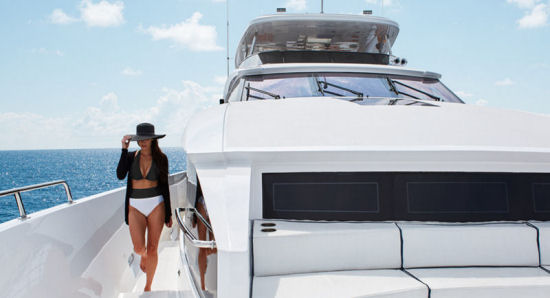
As we said, this is not your father’s Hatteras. The new Hatteras management has changed its focus from targeting graying corporate executives to a far younger and worldlier constituency. Note the high bulwarks and wide side decks.
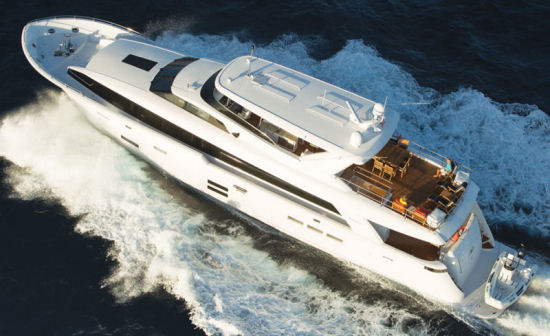
The sheer size of the flying bridge can be seen in this photo with two-thirds of it covered by the hardtop.
The Salon

We don’t often see square dining room tables on motoryachts but they make sense for several reasons – everyone can be in the conversation, a round table for eight would have to be bigger and would waste space, and in this case it fills an area perfectly. Note the wet bar and travertine decking next to the aft door at left. Travertine has texture so is far less slippery than the granite we often see placed here. Of course, people who prefer granite can have it – just be careful when it’s wet.
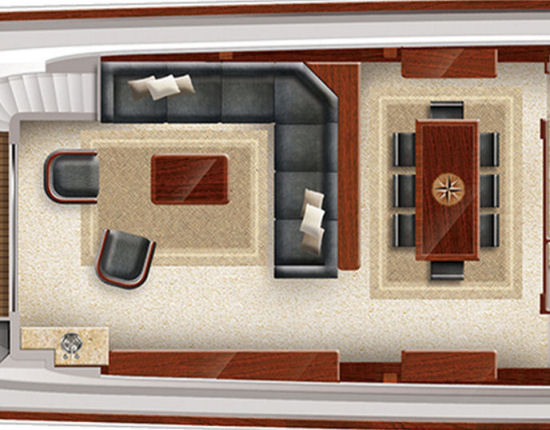
An optional arrangement of the salon of the Hatteras 100 Raised Pilothouse can be seen here with the more traditional long table athwartships. Importantly, with a 22’6” (6.86 m) beam there is plenty of room inside to go either way.
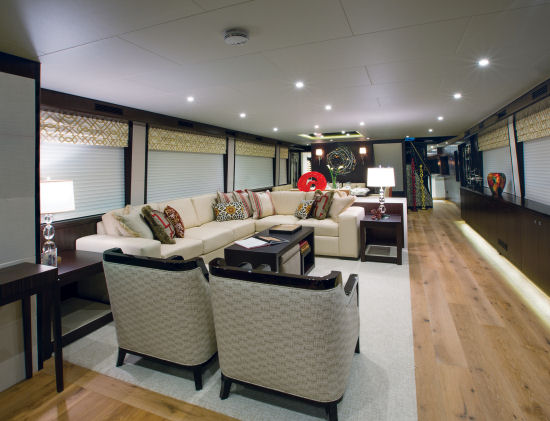
Looking forward on the Hatteras 100 Raised Pilothouse, we see large windows that will give guests a breath-taking view of the seascape when underway. The dark walnut cabinetry contrasts with the light-tone upholstery on the stand-alone furniture. We like the hardwood deck and area carpet.
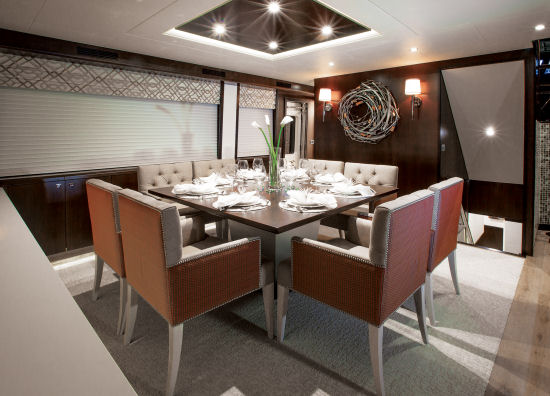
The dining area is large but the square table for eight seems intimate. The table is mirrored overhead by a square soffit with lighting on a rheostat to help create the right ambiance for the occasion. Look carefully in the background to see the passageway to the day head and the pantograph door to the portside deck. To the right of the photo is the companionway to the accommodations deck below.

This is one of the best country kitchen layouts we have seen primarily because the full-sized Jenn-Air stovetop and oven is placed at an angle eliminating a problematical corner. The island bar is well-proportioned to handle both four people and also leave space for food prep and have full storage underneath. The settee at right is raised as is usually the case in layouts of this type. We like the full-sized stand-up refrigerator at left. Make sure there is a latch for the French doors. The hazy gray trapezoid in the middle indicates where the skylight is.
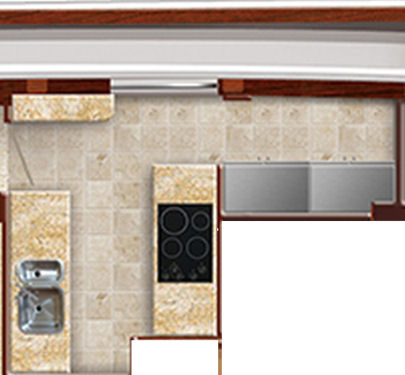
The alternate galley layout is what we describe as a Traditional European galley on a motoryacht of this size. It is smallish, and designed to be out of sight of the guests. Food prep counter space is at a premium, but this is pretty much what these galleys are like even on yachts 25’ (7.62 m) larger. Professional yacht chefs are used to it. The door to the side deck at the top of the picture is for unobtrusive entrance and exit of staff.
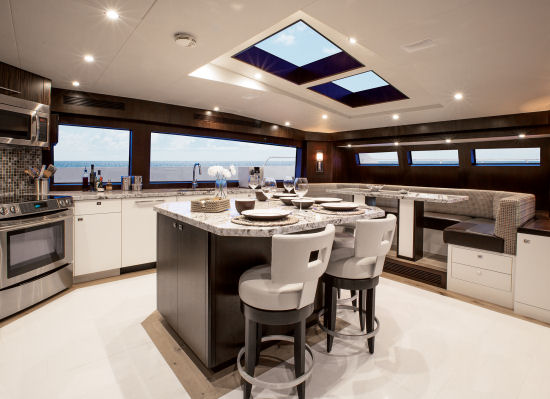
This country kitchen is made open and airy because of the large side windows, sky lights, and cream-colored cabinetry and deck. All counter and table tops are in matching granite. Note the household-sized Jenn-Air range at left.
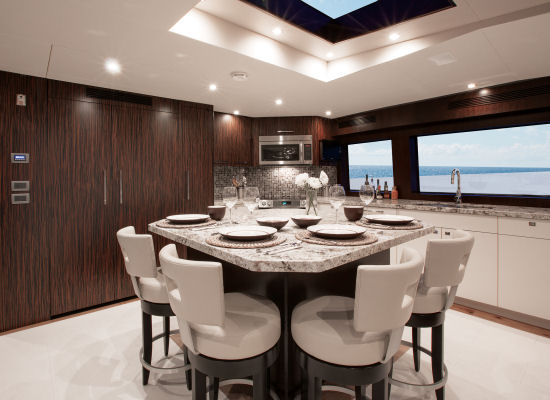
This wide-angle shot shows the full size refrigerator and freezer at left faced with the same walnut veneer used in the rest of the galley.
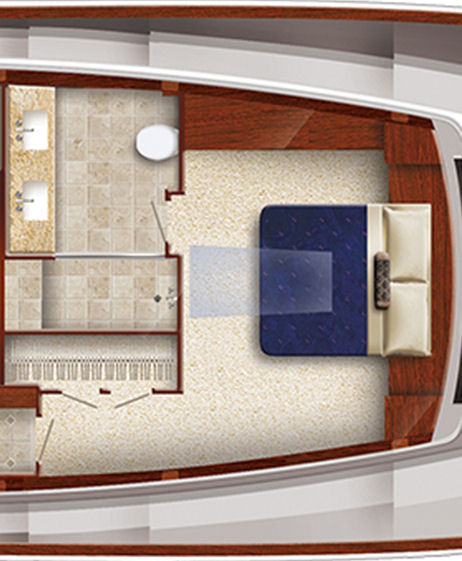
This expanded view is of the optional forward master stateroom (instead of the Country Kitchen). This is a layout traditionally used on custom motoryachts of 125’ and larger and makes the Hatteras 100 Raised Pilothouse a five en suite stateroom vessel, ideal for owners who have lots of friends. This configuration is ideal for socialites who have dozens of friends who would like to join them on exotic cruises to some of the world’s more interesting places. This space can be turned into almost anything – such as a study, TV room, a spa with sauna, steam room and a massage table or two.
The Raised Pilothouse
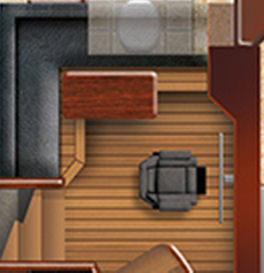
This blow-up of the pilothouse shows that it is the captain’s domain. It is situated between the main salon and dining area and the master or galley forward. It is raised, as the name implies, and is completely isolated from the rest of the boat for night running and guest privacy. The table at the settee can be used for charts, something still needed in some dicey places. (The gray area at the top of the image shows part of the day head under the pilothouse.)
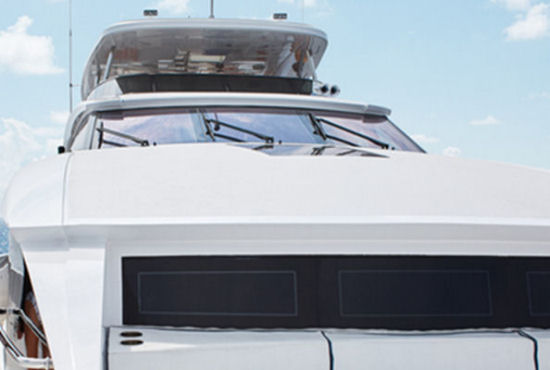
By raising the pilothouse above the main deck level, the Hatteras 100 gets the piloting out of the “public” spaces much like we would expect on a small cruise ship. Just above is the open-air helm on the flying bridge with the wheel and instrumentation on the port side. The black area below houses the windshield that gives forward visibility to the on-deck master or the country kitchen. This is a clever design and one not often seen.
Accommodations

This is the standard accommodations deck floor plan. The full-beam master stateroom is in the center of the vessel making it the most comfortable spot aboard. For owners selecting the five stateroom Hatteras 100 Raised Pilothouse, this stateroom is quite a bit larger than the one on the main deck – so deciding who sleeps where will be a challenge. Note the size of the engine room – the gray space between the master and the crews’ quarters. It is one of the largest engine rooms we’ve seen in class.
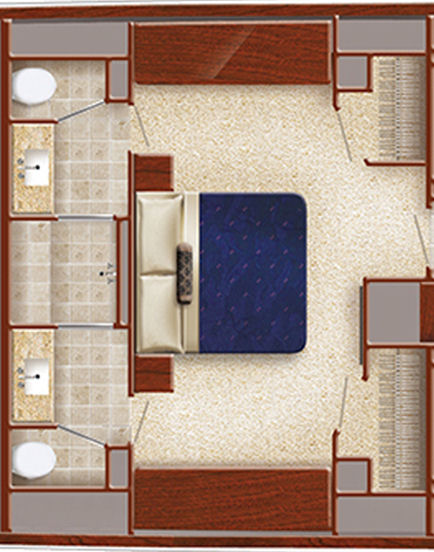
This is the standard layout of the full-beam master stateroom – complete with semi-walk-in closets and his and hers bathrooms and a shower in between. Look carefully and note that both toilets are in enclosed water closets. This is something we often don’t see on yachts even this size. The bath space in this layout is enormous and we can think of all sorts of other design plans – such as making the shower stall a normal width and putting a double sink on one side, thereby opening up the space on the opposite side to be a huge, true walk-in closet; then replacing one of the existing closets with a love seat, or even a little morning coffee nook.
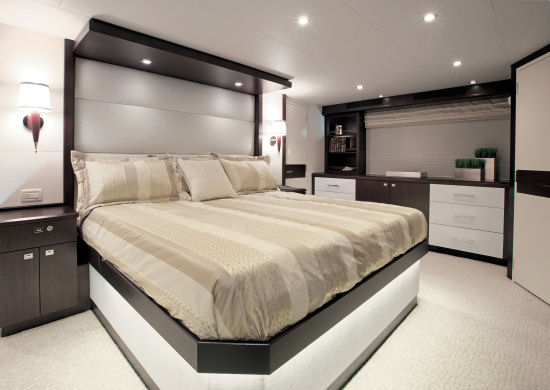
The master stateroom below is as elegant and as tastefully executed as any we have seen in class.
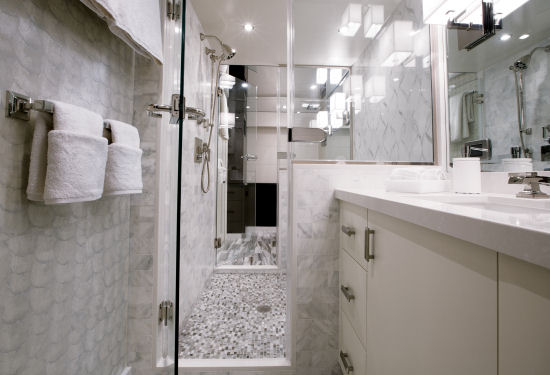
The his-and-hers baths use a rich mix of marble, tile, polished stainless steel, mirrors and glass to make this large space seem even bigger. The shower is double-wide. There are enclosed water closets on both sides.
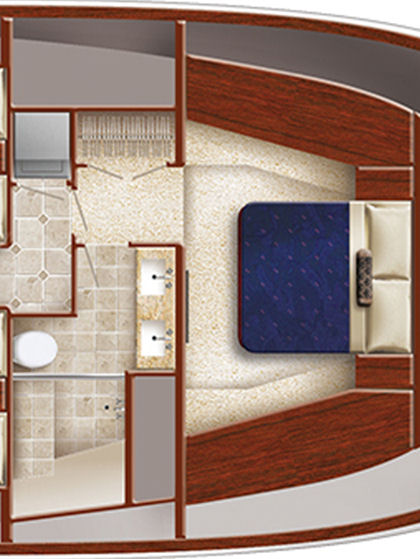
This VIP stateroom in the bow is probably the most private of all of the cabins on the accommodations deck due to the fact that there are three bulkheads between it and the next stateroom. Note the stacked full size washer and dryer at the top left of the drawing.
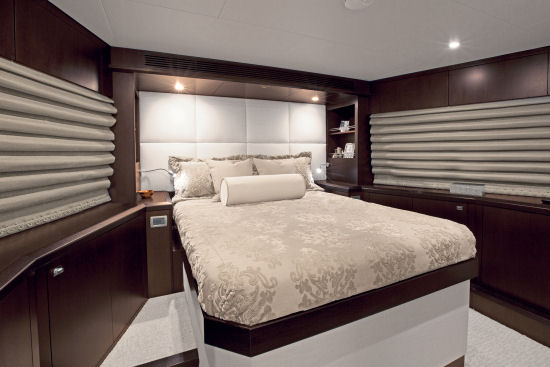
The VIP stateroom in the bow has more room than we usually see on either side of the island bed. The Roman shades are more for decoration as the port and starboard portlights are relatively small. Note the grate over the headboard for AC/heat. The shelves outboard of the headboard are an ideal place to keep books and charging cell phones.
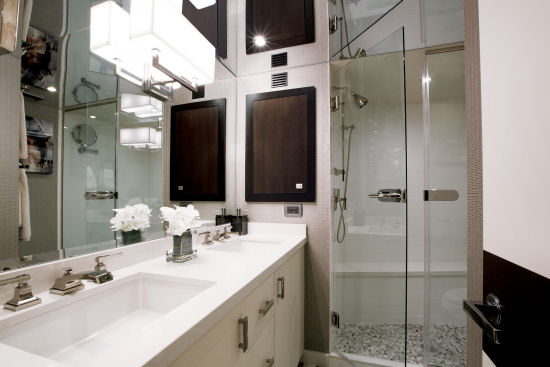
This is one of the largest heads we have seen in the VIP suite on a boat of this size. Note the his-and-hers sinks.
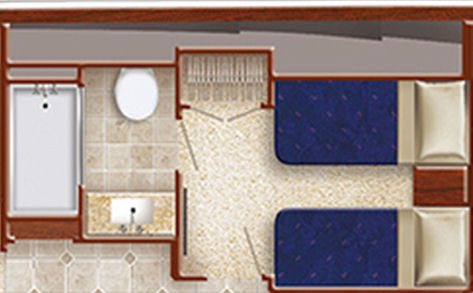
In this guest cabin, again, we see an abundance of space. We don’t often see tubs in yachts any more, even ones this big. Note the relative width of the beds, a place where some builders with narrow boats “cheat” by making them uncomfortably narrow, but these seem to be a practical width. By eliminating the tub and installing a shower there would probably be room for a closet for towels and linen, something that is usually in short supply on any yacht.
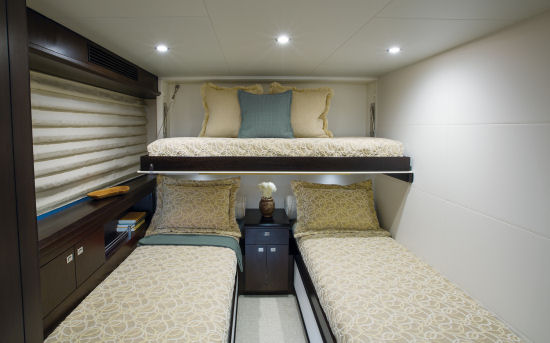
The midships guest staterooms are nearly identical and each have one good-sized window hidden by the Roman shade in this photo. The Pullman berth is a handy option for a guest family with a small child.
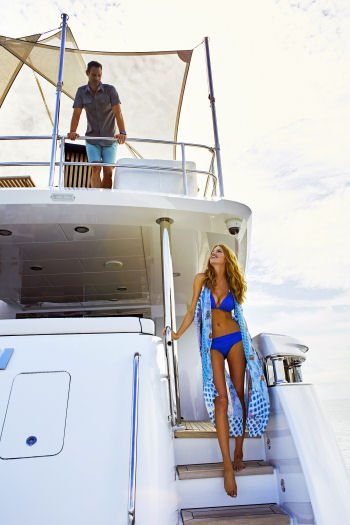
The awnings seen above are a good way of regulating the amount of UV rays guests receive on the sundeck. Note the teak decks and stair treads, and the courtesy lights on the side of the bulwarks.
Crew Quarters, Engine Room, and Tankage
Crew Quarters.
As can be seen in the drawing below, there are two separate en suite cabins in the crews’ quarters plus a mini-galley and lounge. It is designed for four people – captain, mate, chef and steward -- and it has direct access to the engine room. Access to the crew quarters is from a stairway from the aft deck and through the water tight hatch in the transom. The transom hatch is a god-send for the crew as they can keep it open when not underway for fresh air. It also gives them handy access to the swim platform for a little R&R after a hard day.
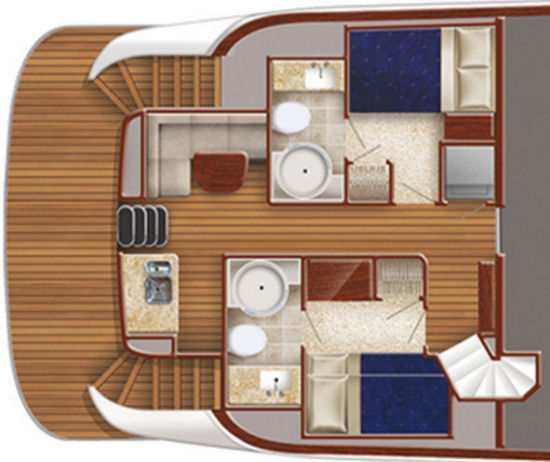
Hatteras has given the crew an outdoor “veranda” which makes a pleasant place to relax after a hard day of boating. Note the lounge and mini-galley.
Engine Room.
What can’t be seen in the drawings is the fact that the engine room has over 6’6” (1.98 m) of headroom, and is quite large by today’s standards. There is over 5’ (1.52 m) of room between the twin Cat C32As and plenty of room outboard. Well-executed engine rooms have always been the forte of Hatteras and this yacht is no exception. Any captain should like it because there is a lot of elbow room and thru-hulls and sea strainers and other daily check points are handy.
Remarkable Tankage.
The Hatteras 100 Raised Pilothouse comes standard with twin 40 kW generators, and like the mains, access to them is easy. Of particular note is the fact that the Hatteras 100 Raised Pilothouse has the largest tankage of virtually any motoryacht in class. In addition to her 4,660 gallon (17,640 L) fuel capacity in four tanks, plus a day tank, there is also 820 gallons (3,104 L) of freshwater capacity. Both of these capacities are nearly twice what many other boats in class have. The holding tanks contain 419 gallons (1,586 L), again, far above average for this class vessel. All of this is indicative of the fact that Hatteras has designed the boat for people who really want to use it – and not just display it.
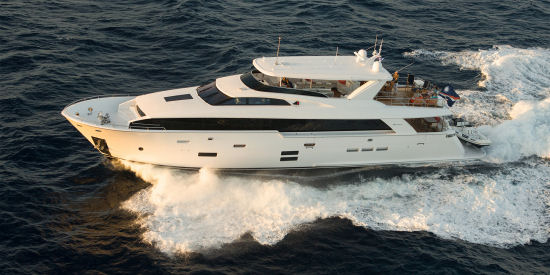
There is more to the Hatteras 100 Raised Pilothouse than meets the eye. She has prodigious fuel capacity at 4,660 gallons (17,640 L) and can easily go trans-oceanic at trawler speeds or better.
Trans-Oceanic.
We have not tested the Hatteras 100 Raised Pilothouse, but we have tested a number of vessels with the Cat C32As with displacements in the 230,000 lbs. (104,326 kg) range. Based on what we have seen, this boat has legs. The advantage of having this massive tankage capacity is manifest. It allows her to run day and night in the 20 knot range and cover something like 400 nmiles in 20 hours or so.
On the other end of the spectrum, her prodigious tankage will allow her cross the Atlantic easily, with stops in Bermuda and the Azores, at speeds faster than most displacement trawlers and long range cruisers. Likewise in the Pacific, she can easily make it to the normal refueling stops at trawler speeds or better – and be a lot more comfortable in the process. And with her high bow, beam and significant displacement, our guess is that she could handle most any reasonable sea condition.
Water Wagon.
We like her 820 gallons (3,104 L) of water capacity because a vessel of this size with a full complement of guests using the showers, and the crew running the washing machines and dishwashers, 800 gallons can be consumed rather quickly. She will obviously have a watermaker if distance running is involved, but having this capacity means she will not have to run the watermaker – which can be somewhat noisy -- so long or so often.
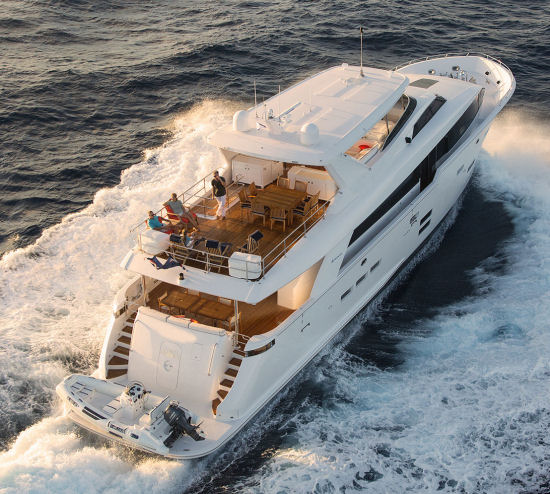
The new Hatteras 100 Raised Pilothouse motoryacht marks a new direction for this venerable brand.
Observations
We have not yet tested the Hatteras 100 Raised Pilothouse so we have many unanswered questions. But what we can tell from what we do know from our cursorily examination is that she is a vessel for all reasons. She has abundant entertaining spaces and all of the amenities that one would associate with a yacht of this caliber.
Hatteras is making her versatile so that she can appeal to a wider range of boaters – everything from the person who wants to use her as a dayboat entertaining platform, to someone who enjoys cruising with his extended family of children and grandchildren, or maybe even three or four other couples for a memorable cruise somewhere fantastic. There is simply no better way to see many parts of the world than by water in a large, well-equipped and crewed motoryacht.
Finally, for that more adventurous couple who want to do some truly long range cruising, but who don’t want to be saddled with a one-trick pony, the Hatteras 100 Raised Pilothouse might be the answer.
We look forward to testing her soon.






































